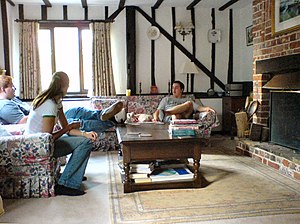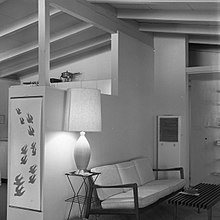Living room
– **Historical Evolution and Cultural Influences:**
– Living rooms have evolved over time, influenced by cultural, historical, and architectural factors.
– The transition from parlors to living rooms reflects changes in domestic spaces and societal norms.
– Different architectural eras have impacted the design and function of living rooms.
– The Industrial Revolution played a significant role in shaping living spaces.
– Cultural influences on living room design are evident in various global styles like Japanese minimalism and Western opulence.
– **Living Room Design and Furniture:**
– Living rooms serve as spaces for relaxation and socializing, featuring furnishings like sofas, chairs, tables, and TVs.
– Furniture in living rooms serves both functional and aesthetic purposes.
– Styles of living room furniture have evolved to reflect changing tastes and lifestyles.
– Modern living room furniture often emphasizes comfort and versatility.
– Unique features like conversation pits have been popular in certain design eras.
– **Cultural Variations in Living Room Design:**
– Living room designs vary across cultures, influenced by traditions and lifestyle preferences.
– Japanese living rooms prioritize simplicity and functionality, while Western living rooms may focus on comfort and entertainment.
– Understanding living room variations in different countries provides insights into cultural values.
– The layout and decor of living rooms can reflect societal norms and personal preferences.
– Cultural diversity in living room design highlights the richness of global interior styles.
– **Etiquette, Social Aspects, and Scholarly Perspectives:**
– Living rooms historically served as spaces for social gatherings and formal interactions.
– Proper etiquette in living rooms can enhance social interactions and guest experiences.
– Scholars have explored the psychological and cultural significance of living rooms.
– Research on living rooms offers insights into human behavior and social dynamics.
– Academic analyses of living rooms shed light on the intersection of architecture and psychology.
– **Architectural Styles and Influential Figures:**
– Louis XIV and Louis XV styles influenced formal and comfortable living room design.
– Mid-century modern design post-World War II prioritized simplicity and honest materials in living room spaces.
– Different architectural styles, from Louis XIV opulence to mid-century minimalism, have shaped living room design.
– Influential figures like Edward Bok promoted the term ‘living room’ for everyday use.
– Designers like Charles Étienne Briseux emphasized comfort and materiality in interior design.
This article needs additional citations for verification. (April 2012) |
In Western architecture, a living room, also called a lounge room (Australian English), lounge (British English), sitting room (British English), or drawing room, is a room for relaxing and socializing in a residential house or apartment. Such a room is sometimes called a front room when it is near the main entrance at the front of the house. In large, formal homes, a sitting room is often a small private living area adjacent to a bedroom, such as the Queens' Sitting Room and the Lincoln Sitting Room of the White House.





In the late 19th or early 20th century, Edward Bok advocated using the term living room for the room then commonly called a parlo[u]r or drawing room, and is sometimes erroneously credited with inventing the term. It is now a term used more frequently when referring to a space to relax and unwind within a household. Within different parts of the world, living rooms are designed differently and evolving, but all share the same purpose, to gather users in a comfortable space.
